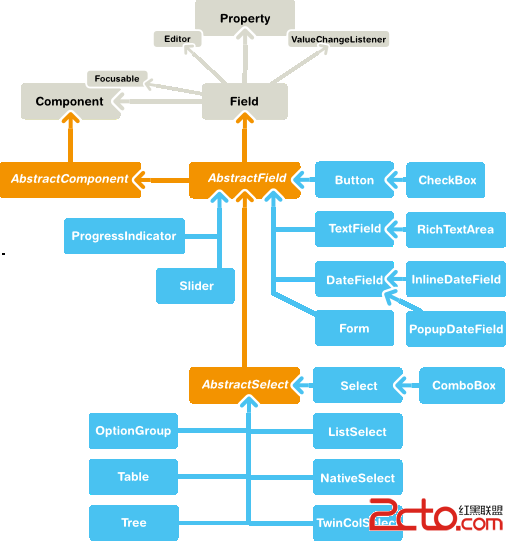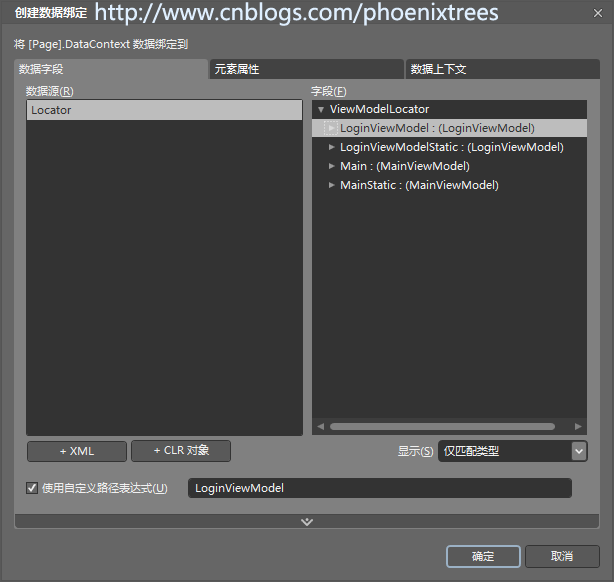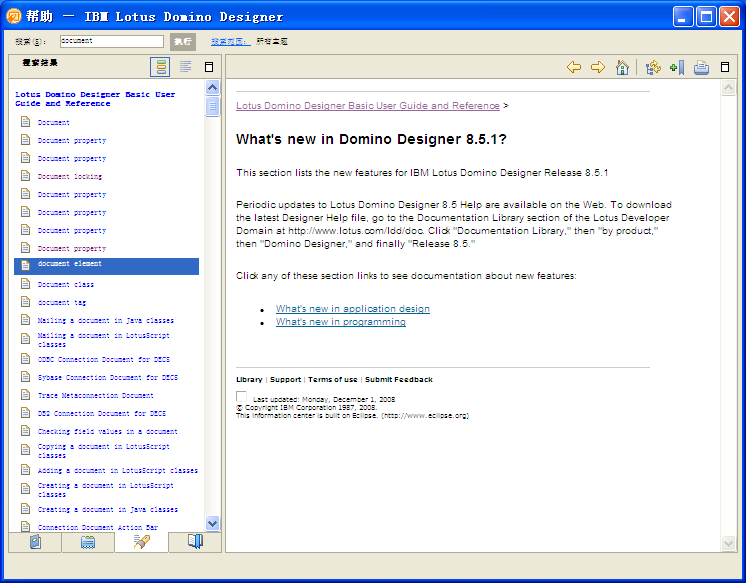Vaadin Web应用开发教程(23):UI组件-Form组件
大部分的Web应用都包含窗体(Form),Vaadin中的Form组件提供了创建窗体的简洁方法。窗体中的填充域可以直接由绑定的数据源自动生成。BeamItem 适配器(Adapter)支持使用Java Bean对象或是普通的Java 对象做为数据源。 Form组件支持窗体数据的缓存从而只需在填写Form完成后一次性提交。
Form 组件从Layout 派生,可以有边框,标题,描述以及错误提示标识。
和大部分UI组件不同的是,Form构造函数不支持传入窗体标题参数,因为From经常不需要显示标题。你可以使用setCaption 为窗体添加标题。setDescription 可以为窗体添加帮助提示。Form组件缺省使用FormLayout 布局,但你可以使用setLayout 为Form组件设置其它Layout对象。
Form组件可以包含其它UI组件,你可以直接创建UI组件如何添加到Form组件的Layout对象中,但更好的方法是使用数据绑定。
下面代码显示两种方法为Form添加其它UI输入组件,如何添加到窗体中:
[java]
Form form = new Form();
form.setCaption("Form Caption");
form.setDescription("This is a description of the Form that is " +
"displayed in the upper part of the form. You normally " +
"enter some descriptive text about the form and its " +
"use here.");
// Add a field directly to the layout. This field will
// not be bound to the data source Item of the form.
form.getLayout().addComponent(new TextField("A Field"));
// Add a field and bind it to an named item property.
form.addField("another", new TextField("Another Field"));
Form form = new Form();
form.setCaption("Form Caption");
form.setDescription("This is a description of the Form that is " +
"displayed in the upper part of the form. You normally " +
"enter some descriptive text about the form and its " +
"use here.");
// Add a field directly to the layout. This field will
// not be bound to the data source Item of the form.
form.getLayout().addComponent(new TextField("A Field"));
// Add a field and bind it to an named item property.
form.addField("another", new TextField("Another Field"));

Form组件可以显示输入错误标识,它可以显示下面几种错误类型:
由setComponentError 设置的错误内容。
由addValidator 添加到窗体的Validator 生成的错误。
由窗体中UI域所关联的Validator引起的错误。此时setValidatorVisible(true)
当setRequired(true) 和setRequiredError 同时设置时未填写某个必需内容时引发的校验错误。
但Form组件同时只能显示单个错误。
此外Form组件还定义了页脚区域(footer),footer 缺省使用HorizontalLayout布局。但也可以使用setFooter 来修改缺省布局。
[java]
// Set the footer layout.
form.setFooter(new VerticalLayout());
form.getFooter().addComponent(
new Label("This is the footer area of the Form. "+
"You can use any layout here. "+
"This is nice for buttons."));
// Have a button bar in the footer.
HorizontalLayout okbar = new HorizontalLayout();
okbar.setHeight("25px");
form.getFooter().addComponent(okbar);
// Add an Ok (commit), Reset (discard), and Cancel buttons
// for the form.
Button okbutton = new Button("OK", form, "commit");
okbar.addComponent(okbutton);
okbar.setComponentAlignment(okbutton, Alignment.TOP_RIGHT);
okbar.addComponent(new Button("Reset", form, "discard"));
okbar.addComponent(new Button("Cancel"));
// Set the footer layout.
form.setFooter(new VerticalLayout());
form.getFooter().addComponent(
new Label("This is the footer area of the Form. "+
"You can use any layout here. "+
"This is nice for buttons."));
// Have a button bar in the footer.
HorizontalLayout okbar = new HorizontalLayout();
okbar.setHeight("25px");
form.getFooter().addComponent(okbar);
// Add an Ok (commit), Reset (discard), and Cancel buttons
// for the form.
Button okbutton = new Button("OK", form, "commit");
okbar.addComponent(okbutton);
okbar.setComponentAlignment(okbutton, Alignment.TOP_RIGHT);
okbar.addComponent(new Button("Reset", form, "discard"));
okbar.addComponent(new Button("Cancel"));
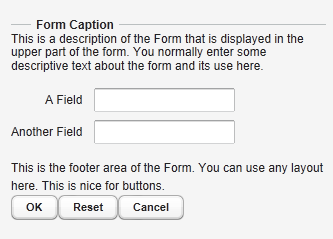
上面介绍了Form组件的基本用法,接着介绍Form组件如何利用数据绑定来自动创建UI填充域。
数据绑定使用的数据源可以为任何实现Item 接口的Java对象。你可以自行实现Item接口或是使用BeamItem Adapter将Form组件绑定到任意的JavaBean对象。 也可以使用PropertysetItem 将Form组件绑定到一个Propert 对象集合。
下面代码定义了个简单的Java Bean对象-PersonBean.
[java]
/** A simple JavaBean. */
public class PersonBean {
String name;
String city;
public void setName(String name) {
this.name = name;
}
public String getName() {
return name;
}
public void setCity(String city) {
this.city = city;
}
public String getCity() {
return city;
}
}
/** A simple JavaBean. */
public class PersonBean {
String name;
String city;
public void setName(String name) {
this.name = name;
}
public String getName() {
return name;
}
public void setCity(String city) {
this.city = city;
}
public String getCity() {
return city;
}
}
如何使用BeanItem 适配器将一个PersonBean对象绑定到Form 组件。
[java]
// Create a form and use FormLayout as its layout.
final Form form = new Form();
// Set form caption and description texts
form.setCaption("Contact Information");
form.setDescription("Please specify name of the person and the city where the person lives in.");
// Create the custom bean.
PersonBean bean = new PersonBean();
// Create a bean item that is bound to the bean.
BeanItem item = new BeanItem(bean);
// Bind the bean item as the data source for the form.
form.setItemDataSource(item);
// Create a form and use FormLayout as its layout.
final Form form = new Form();
// Set form caption and description texts
form.setCaption("Contact Information");
form.setDescription("Please specify name of the person and the city where the person lives in.");
// Create the custom bean.
PersonBean bean = new PersonBean();
// Create a bean item that is bound to the bean.
BeanItem item = new BeanItem(bean);
// Bind the bean item as the data source for the form.
form.setItemDataSource(item);
绑定数据源后,Form组件使用FormLayout,并为Java Bean的每个属性自动创建对应的UI组件(如文本框)。如下图所示:
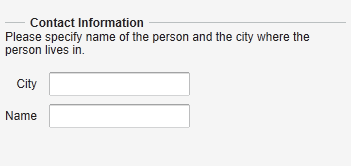
补充:Web开发 , 其他 ,